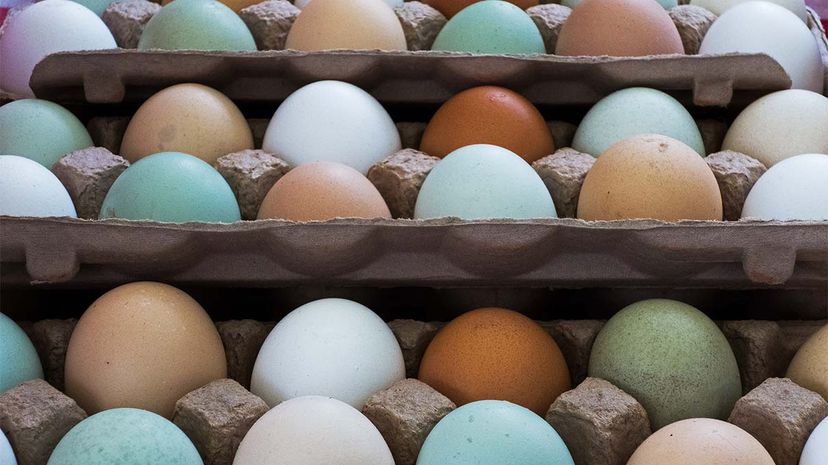
Peruse the egg section of a grocery store or farmers market, and you’ll notice cartons of eggs separated into white and brown, sometimes even green or blue eggs. But once they arrive scrambled on a plate with cheese and tomatoes, perhaps, or baked into a cake, it’s tough to tell the difference. In fact, what is the difference between eggs with shells of different colors?
This isn’t a flour or rice situation. Brown eggs are not more “natural,” and white eggs have not been decolored with bleach. Both varieties occur completely naturally, as do bluish-green chicken eggs. But really, all chicken eggs are the same on the inside. So what causes different egg colors among the same type of bird?
Dr. Justin Fowler (which came first, the surname or the profession?), a professor in the University of Georgia’s poultry science department, shines a light on things. “The different colors, or the presence of spots or speckling, come down to the genetics of the bird,” he says.
“Leghorn chickens (which make up most of the commercial egg industry in the U.S.) lay white eggs, while Orphingtons or Plymouth Rocks will lay brown eggs,” explains Fowler. “The Ameraucana breed has a pigment that is able to permeate the whole egg shell and make blue-colored eggs that are colored on both the inside and outside of the shell.”
Want to know whether a specific chicken will pop out a white egg or a colored egg? Examine the chicken’s earlobe. (Surprise, birds have earlobes!) “Breeds with white earlobes will typically be those that do not put extra pigment on the egg shell before laying,” says Fowler. And more often than not, chickens with lighter earlobes tend to have white feathers, and thus white eggs, while those with colored feathers and earlobes tend to produce colored eggs.
Where does this color come from? Here’s where understanding how an egg comes to be is important. Chicken yolks, or ova, form in the chicken’s ovaries. A fully formed ovum will leave the ovary and be deposited into the oviduct. This part of the chicken’s reproductive system has five distinct sequential segments which the yolk passes through on its way to the outside world, but it’s the fourth one — the shell gland — that affects the color of the egg. This is where the shell forms around the ovum.
“The shell of all chicken eggs are made of calcium carbonate, a crystal that is white in color,” says Fowler via email. “So all eggs are, at least at the start, white. Any that we then see that are other colors have had a pigment deposited on them as they were moving through the oviduct, after the white egg shell had been deposited. You can see this if you open up a brown egg and look at the inside of the shell, it’ll be white.”
Two pigments are responsible for the spectrum of chicken egg color. Shades of greens and blues are caused by the pigment biliverdin, while protoporphyrin is responsible for reddish-brown hues.
The same egg-coloring process holds true for all birds with colorful eggs. American robin (Turdus migratorius) eggs, for instance, are famously blue. The pear-shaped eggs of a common murre (Uria aalge) can sport a blue hue, be speckled or feature brown streaks.
And while we’re on the subject of color and genetics: Curious as to the origins of the iconic yellow legs of the Leghorn chicken? While scientists dating back to Charles Darwin have identified the domestic chicken (Gallus gallus domesticus) as a domesticated subspecies of the red junglefowl (Gallus gallus), Swedish researchers in a 2008 study identified early crossbreeding with the grey junglefowl (Gallus sonneratii) as introducing the genes behind the modern chicken’s yellow legs.
Oh, but that egg-inside-an-egg story that’s going around the internet right now? That’s another thing entirely, and involves an egg accidentally reversing its course in the oviduct.
Should chicken eggs be kept refrigerated or at room temperature? It depends on whether you live in a country (Australia, Japan and the United States, for instance) that requires eggs produced for commercial sale be washed. This process protects against salmonella, but also removes a waxy shell coating that naturally defends eggs against microorganisms, thereby necessitating refrigeration.


 Users Today : 690
Users Today : 690 Total views : 486939
Total views : 486939